Geneva Grand Prix Round 1 & 2: Hari off to a great start!
Eighteen of the world’s biggest talents in the game of chess have gathered at the Le Richemond Hotel in Geneva for the third leg of the FIDE Grand Prix. The stellar field includes some of the very best in the world including Norway Chess winner, Levon Aronian; world number 6, Shakhriyar Mamedyarov; the Dutch number one, Anish Giri; the women’s number one, Hou Yifan; and many more. The only Indian playing at the event is GM Pentala Harikrishna. Along with a hefty prize fund of € 130,000, on the line are two spots at the Candidates 2018 – the tournament whose winner gets the right to challenge the world champion. A report on the first two rounds.
Grand Prix is a series of four tournaments which includes twenty-four players chosen on the basis of several criteria. This includes the current world champion and his challenger; semi-finalists of the previous FIDE World Cup; players with the highest average rating in the last one year; the highest placed participant of the ACP Tour; nine nominees nominated by AGON, the commercial partner of FIDE; and replacements, if any player chooses not to participate, from those with the highest average FIDE ratings. Each tournament features eighteen of the twenty-four qualified players and every player can participate in three out of the four tournaments. Based on their performance in every individual tournament, players are assigned Grand Prix points. At the end of all the four events, two players with the highest Grand Prix points qualify for the Candidates tournament. Current overall standings are given below.
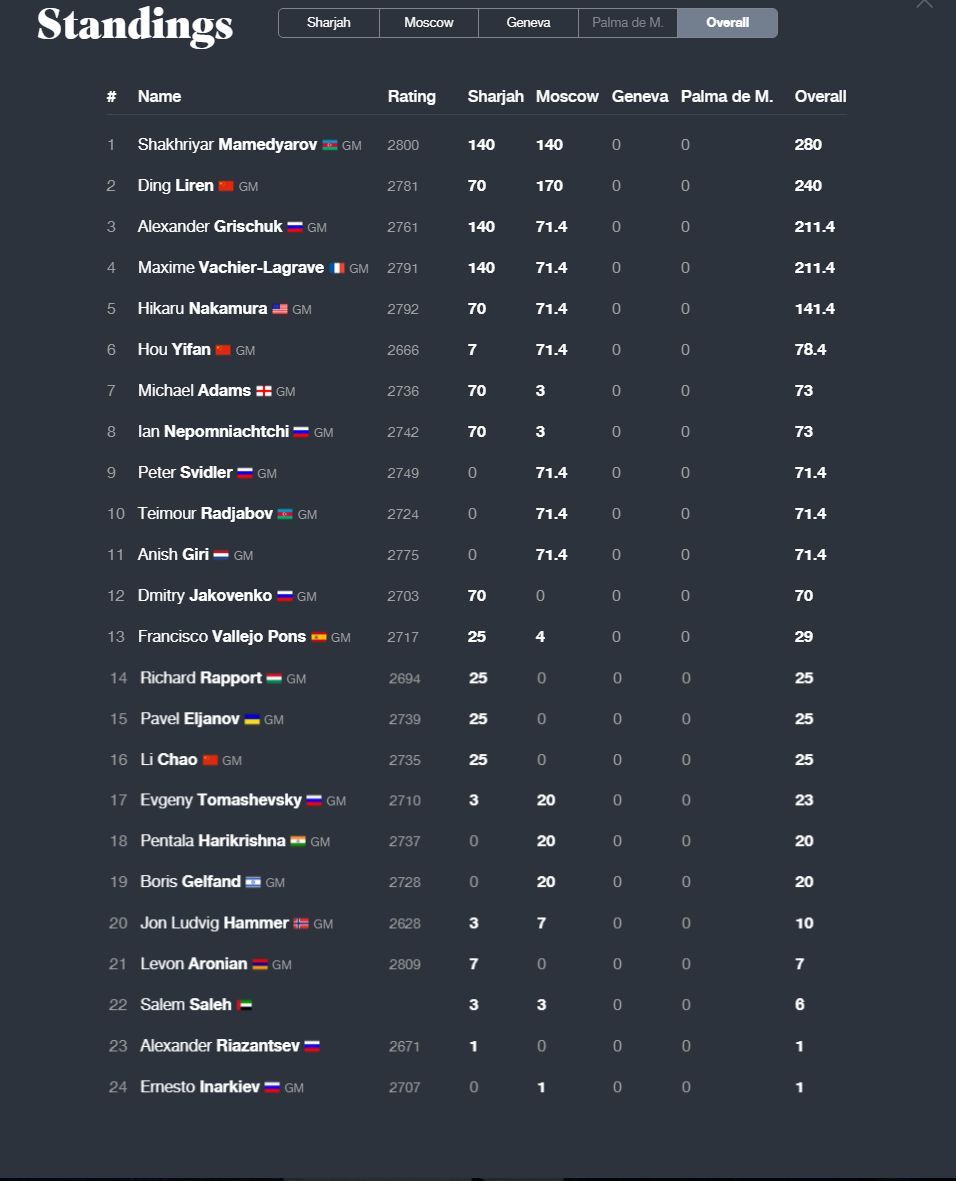
Currently, the Indian number two, Pentala Harikrishna is in the 18th place in the overall standings. But this is only his second tournament in the Grand Prix. The first one he played was the Moscow Grand Prix held in Moscow in May this year. In the Moscow tournament, Hari finished joint-fourth with a score of 4.5/9 along with Boris Gelfand and Evgeny Tomashevsky. With two more tournaments to go, Hari’s chances cannot be discounted. However, the leaders, Shakhriyar Mamedyarov and Ding Liren (who played in both Sharjah and Moscow) have amassed a huge total score in their last two events. Keeping this in mind, Hari will have to finish among the toppers in this and the next Grand Prix tournament in order to have a claim on one of the two spots for the Candidates.

Hari’s first round game in Geneva was a long, uphill struggle that lasted 84 moves. Kicking off with the Nimzo-Indian defence, Hari essayed the classical variation of the opening. As the middle game commenced, the Indian ace began manoeuvring his knights to neutralise his opponent’s centre control. The computers didn’t seem to like this plan, however, and within just a few moves, Riazantsev was able to generate pressure on black’s queenside. After some ups and downs, the players reached an endgame where Hari had a nice blockade on his opponent’s central pawns along with a passed pawn on the queen’s wing. On the other hand, Riazantsev was defending well and the position was within the realms of defensibility despite Hari having some pressure on the queenside. Unable to find the right plan, Hari started shuffling his pieces when time trouble approached. Low on time, Riazantsev erred on move 65 allowing his opponent’s queen into his position. The rest was just a matter of technique for the Indian star.
[Site "Geneva"]
[Date "2017.07.06"]
[Round "1"]
[White "Riazantsev, Alexander"]
[Black "Harikrishna, Pentala"]
[Result "0-1"]
[ECO "E34"]
[WhiteElo "2654"]
[BlackElo "2737"]
[Annotator "Tanmay Srinath"]
[PlyCount "167"]
[EventDate "2017.??.??"]
Champion Riazantsev was an interesting struggle. The Russian GM got an early
advantage, but Hari defended well, and in time trouble started taking
advantage of Riazantsev's mistakes. On move 64 the Russian GM cracked and
tried to complicate the issure, but Hari was upto the task and got a big edge.
The fatal blunder occured on move 74, and Riazantsev resigned on move 84.} 1.
d4 Nf6 2. c4 e6 3. Nc3 Bb4 {The Nimzo is the one of best ways for black to
fight against the Queen's Gambit.} 4. Qc2 {The Classical System. White
prevents doubling of his pawns at the cost of his kingside development.} d5 5.
cxd5 Qxd5 {This is the famed Romanishin System.} 6. e3 c5 7. Bd2 Bxc3 8. bxc3 {
Riazantsev makes a very interesting decision, crippling his queenside, but
strengthening his centre.} (8. Bxc3 {is more commonly seen at the top level.}
cxd4 9. Bxd4 Nc6 10. Bc3 O-O 11. Nf3 Rd8 12. Be2 Qe4 13. Rc1 Qxc2 14. Rxc2 {
is Nakamura,H (2785)-Karjakin,S (2781) Stavanger 2017, that ended in a draw.})
8... O-O 9. Nf3 Nc6 10. c4 {Riazantsev seeks to gain a tempo and open his
bishops, but creates hanging pawns in the centre.} (10. Bd3 $6 c4 11. e4 cxd3
12. exd5 dxc2 13. dxc6 bxc6 14. Rc1 Ba6 15. Rxc2 Bd3 {and only black can claim
a better game.}) (10. Be2 {can transpose to the game after} cxd4 11. exd4 b6
12. c4 Qd6 {But black has an improvement with} (12... Qe4 $1 {with rough
equality.})) 10... Qd6 11. Bc3 (11. dxc5 Qxc5 12. Rb1 e5 13. Ng5 h6 14. Ne4
Nxe4 15. Qxe4 Rd8 {is an old game: Alekhine,A-Euwe,M Netherlands 1937, that
ended in a draw.}) 11... cxd4 12. exd4 b6 13. Be2 Bb7 14. O-O Rac8 {an
improvement over a previous game.} (14... Ne7 15. Ne5 Rac8 16. Qb2 Qc7 17. Rac1
Rfd8 18. Rfd1 Ng6 19. Nxg6 hxg6 20. Qa3 $14 {1-0 (36) Garcia,J (2324)-Garcia
Vasquez,J (2237) Lima 2004}) 15. Rfd1 Ne7 {Seeks to stop d5 once and for all.
Once the pawns are rendered immobile, they become targets.} 16. Qb3 Rfd8 {
Riazantsev is stopped from playing d5, and he now seeks a different plan,
trying to use b6 as a hook to open the b-file.} 17. Ne5 Ng6 18. Bb2 Nd7 $6 {
Hari successfully forces the exchange of the pesky e5 knight. However, he
wastes too much time.} ({Houdini 5 suggests instead} 18... Qc7 19. Qe3 Nxe5 20.
dxe5 Ne4 21. a4 a5 22. Bd4 Nc5 $11) 19. Nxg6 hxg6 20. a4 $1 {[%cal Ra4a5] Now
Riazantsev executes his a4-a5 ideas.} Nf6 {Now we see why Nd7 was dubious- it
has to return to f6 and fails to prevent a5.} 21. a5 $16 Qc7 22. axb6 axb6 23.
Rab1 {Very unnatural. I understand that b6 is weak, but this is too
materialistic.} (23. Ra7 {What is wrong with this move? I think Riazantsev
feared exchanges down the a-file, but I seriously believe he didn't go deeper.}
{After} Ne4 24. Qe3 Qb8 25. Rda1 Nd6 26. Qe5 $16 {Black is in a bind, and
white has a much better position.}) 23... Ne4 24. Rbc1 {[%cal Rc4c5,Rd4d5] The
hanging pawns start flexing their muscles.} Qf4 $1 {A good move by Hari,
seeking counterplay on the white monarch.} (24... Ra8 {is considerably weaker,
as after} 25. Qe3 Ra2 26. Rc2 Qc6 27. f3 Qa4 28. Rdc1 $16 {White has a
commanding position.}) 25. f3 Nf6 $6 {Wrong retreat.} (25... Nd6 {and black is
slightly worse at most.} 26. d5 Re8 27. Bf1 Nf5 28. d6 Nxd6 29. Qxb6 Nf5 $14)
26. Rc2 {A good move, but there was a better one.} (26. Ra1 $1 {[%cal Ra1a7]
it is, as after} Qc7 27. Bc1 Ra8 28. Be3 Ra5 29. Rdb1 Ba6 30. Rc1 Rc8 31. Qb2
Rh5 32. g3 $16 {b6 is very weak, and white claims a big advantage.}) 26... Qc7
27. Bc1 $6 {I don't understand this move. I felt the bishop was fine on b2. I
guess White plans Be3 and d5 in some lines, but I am not entirely sure it is
the best plan.} (27. Rcd2 $16 {[%cal Rd4d5] is a simple move, planning d5.})
27... b5 $1 {A very strong move by Hari, who is showcasing his defensive
skills.} 28. c5 $2 {A bad reposte by the Russian.} ({Ofcourse not} 28. cxb5 $4
Qxc2 $19) ({But} 28. Rb2 {deserved a shot as after} Rb8 29. cxb5 Rdc8 30. Bd2
Nd5 31. Be1 Qb6 $16 {I don't see a bright future for black.}) 28... Bd5 $1 $11
{The position has stabilised, and both players now make meaningful additions
to their positions.} 29. Qb4 Bc6 30. Bg5 Nd5 31. Qb2 Re8 32. Ra1 Ra8 33. Rcc1
Qb7 34. Bd2 Rxa1 35. Rxa1 Ra8 36. Ra5 $2 {The Russian GM loses the thread in
time trouble.} (36. Rxa8+ Qxa8 37. Bd3 Qa4 38. Kf2 $11 {was the simplest path
to equality.}) 36... Rxa5 37. Bxa5 b4 $1 {Riazantsev has clearly miscalculated,
as he now finds himself worse.} 38. Bc4 Ne3 39. Be2 b3 40. Bd2 Nf5 41. Bc3 Bd5
42. Qc1 Ne7 43. Bb2 Nc6 44. Qc3 Kf8 45. Kf2 Ke7 {An okay move, although I
would play} (45... g5 $1 $17 {Preventing h4 and some play on the kingside.})
46. Qd2 Qb8 47. h3 Kf8 48. Bd3 Kg8 49. Qe1 Qf4 {Hari is better, but the
Russian GM defends well.} 50. Qe3 Qh4+ 51. Kg1 Qd8 52. Kf2 Qa5 53. Qe1 Nb4 54.
Bb1 Qb5 55. Qc3 Qa4 56. Kg1 Kf8 57. Kf2 Nc6 58. Kg1 Ke8 59. Kf2 Kd7 60. Qd2 Kc8
61. Qc3 Na5 62. Bd3 Bc4 63. Bb1 Nc6 {Till now Hari has put a lot of pressure,
and it starts to tell on Riazantsev.} 64. d5 $6 {An unecessary effort to force
the issue. Riazantsev snaps under pressure, and loses a pawn.} (64. Qe3 Nb4 65.
Qf4 f5 66. Qe5 Qd7 $15 {and I see no immediate loss for white here, though his
position remains unpleasant.}) 64... Bxd5 $17 65. Qxg7 $2 {An error in
judgement. Why undouble black's g pawns and give up h3? Clearly, Whte missed
the fact that he gets just 1 check at the the black king.} ({Houdini suggests}
65. Bd3 f6 66. Bxg6 Ne5 67. Bd3 Kd7 68. Bf1 Kc6 69. Kg3 Nd7 70. Be2 e5 $17 {
as a possible improvement, but I feel Black is close to winning here as well.})
65... Qh4+ $1 $19 {Black gets the h3 pawn, and stays a pawn up. Now it is
almost over} 66. g3 Qxh3 67. Qg8+ Nd8 68. Qh8 Qxh8 69. Bxh8 Nb7 {[%cal Rb7c5]}
70. Ke3 Kd7 71. f4 Nxc5 72. g4 $2 {The last mistake. White now loses quickly.}
f5 $1 $19 73. gxf5 exf5 74. Bd3 Kc6 75. Be2 Na4 76. Bd1 Kc5 $1 {[%cal Rb3b2]
Threathening b2.} (76... b2 $4 {is an unnecessary rush of blood that loses
after} 77. Bxa4+ $1 $18) 77. Bd4+ Kb4 78. Bg7 Be4 79. Bf8+ Kc4 80. Be2+ Kd5 81.
Bd1 b2 82. Bb3+ Kc6 83. Bxa4+ Kb7 84. Kd4 {and Riazantsev threw in the towel.
A great game by the Indian GM, who weathered the early storm and took
advantage of his opponent's mistakes to secure an edge. It shows the value of
patience at the top leve, as Riazantsev just cracked after a long and arduous
defense.} 0-1
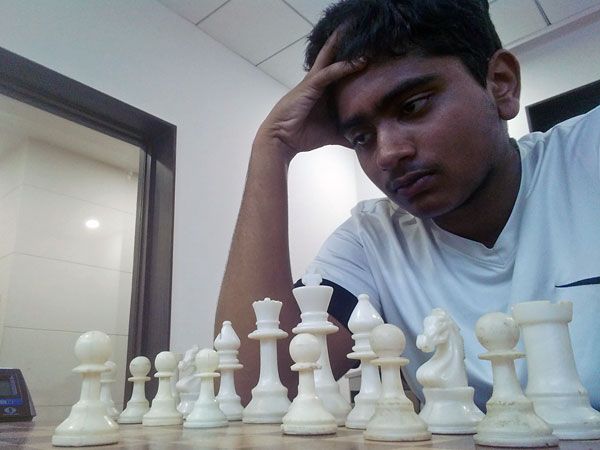
The annotator for this and the second round game of Harikrishna is 16-year-old Tanmay Srinath. Tanmay is an ardent lover of the game and likes to follow top level chess. He will be annotating Harikrishna's game at the Geneva Grand Prix. Tanmay is also a black belt and an expert in Taekwondo. ChessBase India aims to promote talents like Tanmay, who write so very well. If you would like to contribute to our newspage with articles or analysis, do write to us at chessbaseindia@gmail.com.
Among the other games of the round, Anish Giri had a slight upset as he lost to Teimur Radjabov with the white pieces; Pavel Eljanov got the better of the top rated woman in the world, Hou Yifan; the English number one, Michael Adams won against GM Salem Saleh; while Levon Aronian wriggled out of an inferior position with a draw against Li Chao.
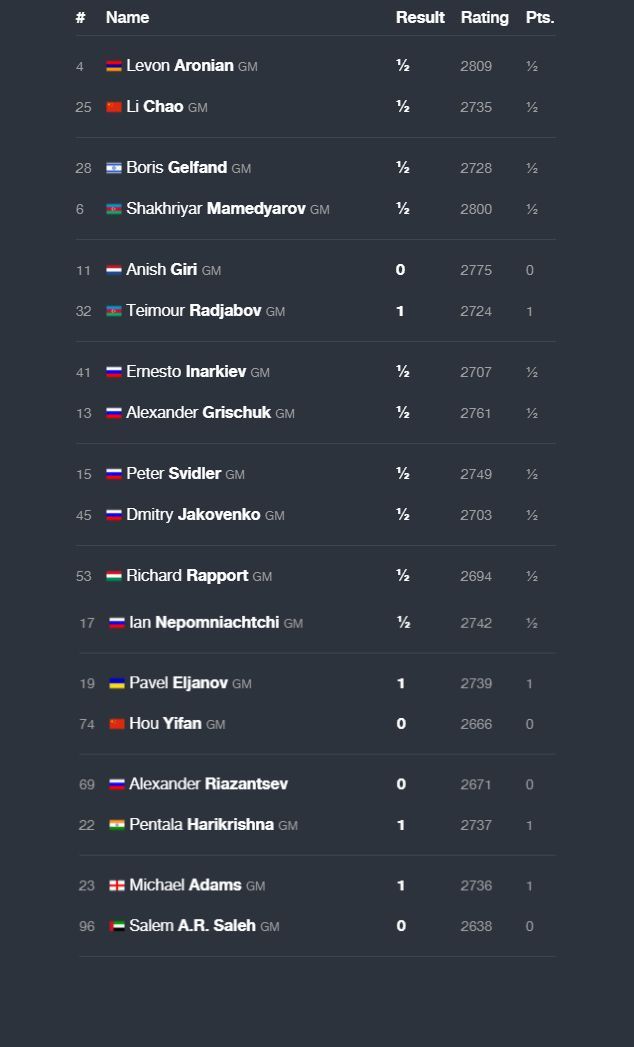
Round 2
After some exciting games in round one, more fireworks were witnessed in the second round of the Geneva Grand Prix. The Azeri star, Shakhriyar Mamedyarov won in merely 20 moves against Ernesto Inarkiev. In a game that opened with the Queen’s Gambit, Mamedyarov allowed his opponent to solidly defend the gambit pawn Shakh had sacrificed early in the game. As play proceeded, the Azeri GM started attacking Inarkiev’s queen which was slightly exposed on the queen side. The game got complicated in no time after this and pieces were en prise all around. By move 19, although Mamedyarov had decent pressure, the position looked a lot calmer. This is where the Russian Grandmaster made a fatal error by castling queenside, missing that his queen could be trapped in just one move. As soon as Mamedyarov played the right move over the board, Inarkiev resigned in no time.
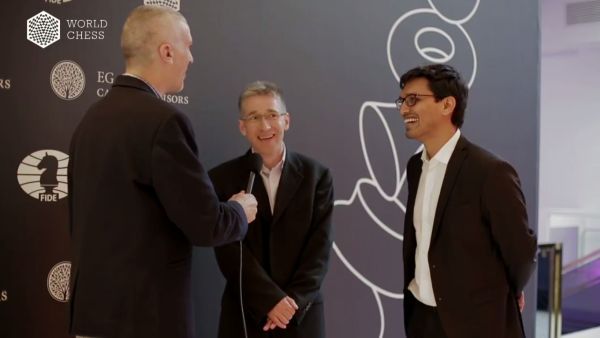
[Site "Geneva"]
[Date "2017.07.07"]
[Round "2"]
[White "Harikrishna, Pentala"]
[Black "Adams, Michael"]
[Result "1/2-1/2"]
[ECO "C54"]
[WhiteElo "2737"]
[BlackElo "2736"]
[Annotator "user1"]
[PlyCount "76"]
[EventDate "2017.??.??"]
{Harikrishna is off to a good start, scoring 1.5 out of 2 in his 1st two games.
He is a very versatile players who can open with 1.e4 or 1.d4. In this game he
faces the English No.1 Micky Adams.} 1. e4 e5 2. Nf3 Nc6 3. Bc4 {The current
tabiya in top level chess, the quiet Italien has existed since the 1900s, but
only at the turn of the century did people start to take notice. But this
really exploded only in the 2010s, and is played in more than half of the
white games opened with e4. Top GMs prefer this as white as it helps avoid the
Berlin, and is a theoretical gold mine.} Bc5 4. c3 Nf6 5. d3 O-O {Adams
prefers to castle and complete his development quickly. There are other viable
alternatives.} (5... d6 {is the most common move in this position. Here, there
are many moves for white, but I will mention only the main line} 6. Bb3 a6 7.
h3 Ba7 8. Nbd2 O-O 9. Nf1 d5 10. Qe2 Be6 {was Tiviakov-Sargassian, that ended
in a draw.}) 6. Bg5 {A relative sideline compared to Bb3 and Nbd2, but with
the most scope of innovation.} h6 7. Bh4 Be7 8. a4 {Hari chooses another
unexplored move. The game now turns very interesting.} ({There are 33 games of
} 8. Nbd2 {in the Live Database. One of the top level games continued} d6 9.
Bb3 Nh5 10. Bg3 Na5 11. Bc2 f5 {1-0, Vachier Lagrave-So, Paris GCT Blitz}) 8...
a5 {Adams prevents a space gaining a5 and renders b4 implausible for the
moment, but the a5 pawn might turn out to be a weakness.} 9. Nbd2 d6 10. Bg3
Nh7 {This move's purpose is to exchange knights with Ng5, as done in the game.
It also can reach f4 via e6 and f8, and it frees the f pawn, which can be
advanced to f5 after Kh8. But there were alternatives.} (10... Be6 {is one,
aiming to exchange the Bc4. But I am not sure who benifits more after the
exchange.} 11. Bxe6 fxe6 12. Qb3 Qd7 13. O-O Rad8 14. h3 Nh5 15. Bh2 Nf4 16.
Bxf4 Rxf4 17. Rfe1 {and white maintains a nagging edge.}) 11. Qb3 {Hari stops
Be6 for now, and prevents the Kh8 and f5 plan previously mentioned. He is also
delaying castling as long as possible.} Ng5 12. Nxg5 Bxg5 {Adams too completes
his plan.} 13. Nf3 Bf6 14. h3 Rb8 15. Rd1 Bd7 16. O-O {Now that Hari has
played Rd1, he has improved all his pieces to their current best positions.
Also, 0-0-0 is no longer possible. So he finally castles, and completes his
development.} Qe8 {A multipurpose move. It provides extra protection to f7 and
e5, and possibly prepares a b5 break after Ne7.} 17. Bb5 Qe6 18. Qc2 Rfd8 19.
Nh2 {The past few moves have been made with a purpose for both players- White
to support d4, and black to prevent it.} Bg5 {I'm not sure about this move,
even though the engines recommend it.} 20. Qe2 {I'm not sure about this move,
even though the engines recommend it. Also, I believe that allowing the queen
to b3 as Hari did in the games only makes matters harder.} ({I would play} 20.
f4 exf4 21. Bxf4 Bxf4 22. Rxf4 Ne5 23. Bxd7 Rxd7 24. d4 Ng6 25. Rf2 Re7 26. Re1
{and White remains slightly better.}) (20. Nf3 {The engine's recommendation.
After} Bf4 21. Bxf4 exf4 22. d4 Qg6 23. Qd3 Re8 24. Rfe1 $16 {Black is looking
at a hard game ahead.}) 20... Ne7 21. Bxd7 $5 {An interesting decision to
exchange the good Bb5 for the slighly bad Bb7.} ({I would retain the bishop
with} 21. Bc4 {and after} Qg6 22. d4 $14 {White has the better chances.}) 21...
Rxd7 22. h4 $5 {A move that doesn't make sense on first glance, but it is made
clear after the next 3 moves.} Bf6 23. Ng4 Ng6 24. h5 $5 Nf4 25. Bxf4 exf4 26.
d4 {[%csl Rf6,Gg4] that White wanted this position the moment he exchanged the
LS Bishops and played h4. Hari wanted to play along the lines of good knight
vs bad bishop. Still, I see this manuever as something that reduced his
advantage.} Bg5 27. e5 $5 Re8 $1 {[%csl Re5] Now the position becomes a
slugfest of tactical ideas, and Hari's pleasant advantage ceases to exist.} 28.
Qf3 Qb3 $1 {Adams is quick to pounce on Hari's lacklustre play to gain
counterplay against white's fragile queenside.} 29. Rde1 {[%csl Re8][%cal
Re5d6] Hari takes aim at the undefended Re8 and threatens exd6.} Rde7 {Adams
calmly defends his rook and again threatens to start munching the queenside.} (
{Obviously,} 29... Qxb2 {can't be played, as after} 30. exd6 $1 $18 {White is
clearly winning.}) 30. Rb1 Re6 31. g3 dxe5 (31... fxg3 32. Qxg3 dxe5 33. dxe5
Qb6 34. b4 Rc6 35. Kh2 $13 {is very complicated. With both players low on time,
Adams decides to keep it simple.}) 32. dxe5 Qxa4 33. b4 {Hari now finds the
right moves and liquidates.} Qc6 $5 {very interesting choice by Adams,
accepting the virtual draw offer.} (33... f5 {was possible, aiming to play for
the win, but after a long computer line} 34. exf6 Bxf6 35. Nxf6+ Rxf6 36. Qxb7
Qd7 37. bxa5 f3 38. Rfe1 Rxe1+ 39. Rxe1 Qh3 40. Qd5+ Kh7 41. Qd3+ Rf5 42. Qf1
Qxf1+ 43. Kxf1 Rxa5 44. Re3 Rxh5 45. Rxf3 Rc5 {the position becomes equal.})
34. Qxc6 Rxc6 35. gxf4 Bxf4 36. bxa5 Bxe5 37. Rfe1 Rce6 38. Re3 b6 {Both
players decide to call it a draw. A good game by the Englishman Adams, who
played well and got rewarded with some chances to push. Though he didn't take
it, it a was a great effort. Harikrishna on the other hand will be
disappointed that he dindn't make the most accurate moves in a better position,
and making suspicious plans and exchanges. Still, it is a long tournament, and
I feel he will definitely fancy his chances.} 1/2-1/2
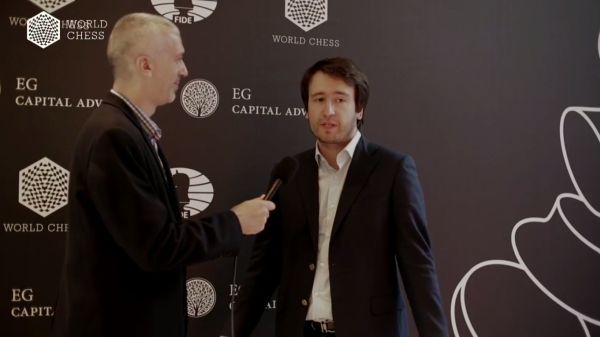
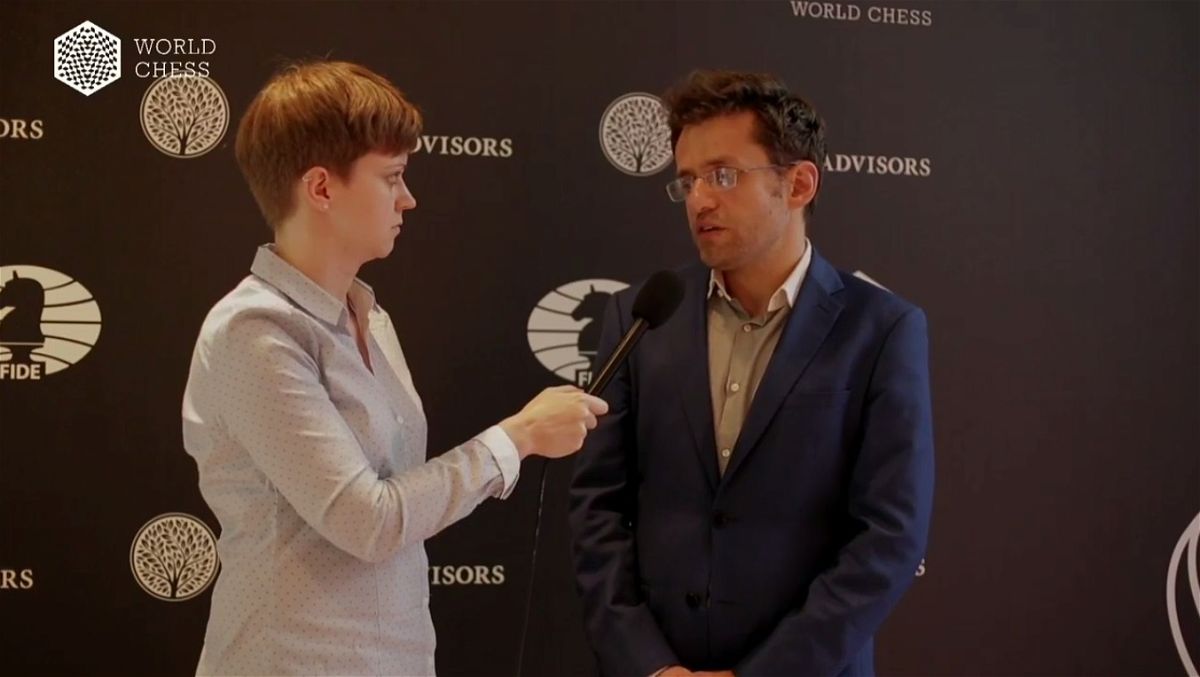


Having won both his rounds, Teimur Radjabov is leading the tournament with 2.0/2. Harikrishna is sharing the second spot along with Adams, Mamedyarov, Grischuk, and Aronian with a score of 1.5. Giri, Svidler, Nepomniachtchi, Eljanov, Li Chao and Boris Gelfand are on the third spot with 1.0/2. Half-a-point behind them are Inarkiev, Jakovenko, Rapport, Riazantsev and Hou Yifan who have scored 0.5/2. Grandmaster Salem Saleh is at the bottom of the table with 0.0/2.
Pairings for round 3: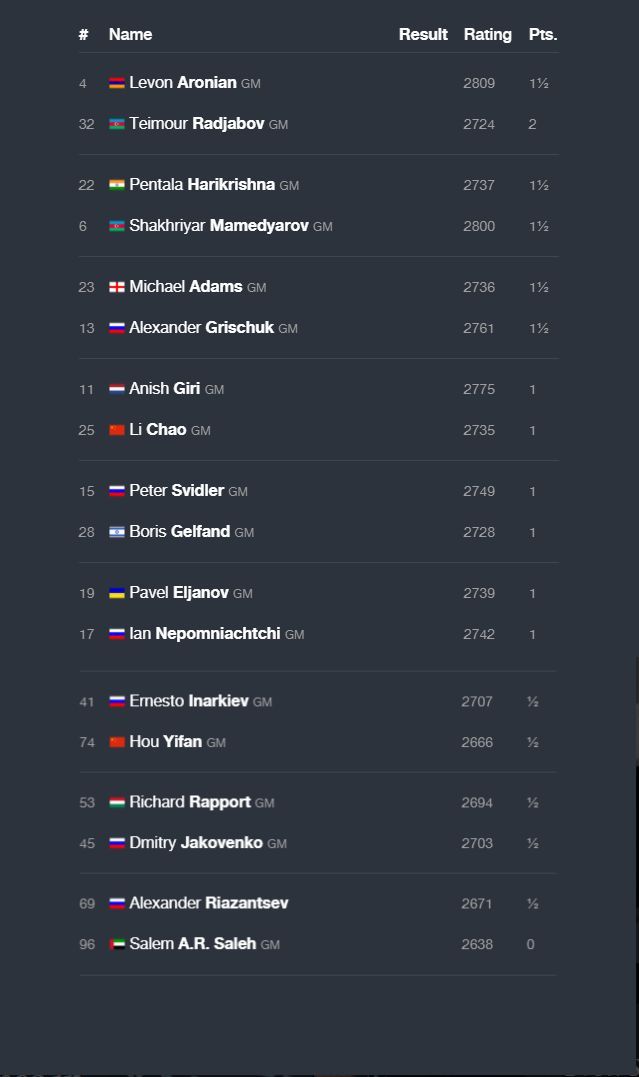
About the author

Aditya Pai is an ardent chess fan, avid reader, and a film lover. He has been an advertising copywriter and is currently pursuing a Master's in English Literature at the University of Mumbai. He loves all things German and is learning the language. He has also written scripts for experimental films.
